Health Promotion Campaign for Cardiac Health in the UK
VerifiedAdded on 2020/05/28
|15
|3593
|35
Report
AI Summary
This report focuses on cardiac health promotion within the UK, addressing the rising rates of cardiovascular disease and its impact on the population. It begins with an abstract summarizing the core issues, followed by an introduction that defines health and health promotion. The report provides a rationale supporting the health issues, citing statistics on mortality rates and risk factors such as sedentary lifestyles, poor diets, smoking, and alcohol consumption. It then explores models for planning a health promotion campaign, specifically referencing the Precede-Proceed model, which is used to design a public health campaign. The campaign utilizes audio-visual media and poster presentations for health education. The report also details evaluation methods used to assess the effectiveness of the campaign. The report concludes by summarizing the key findings and recommendations for future health promotion efforts. The report also includes resources for planning the health promotion campaign and concludes by summarising the key findings and recommendations for future health promotion efforts.
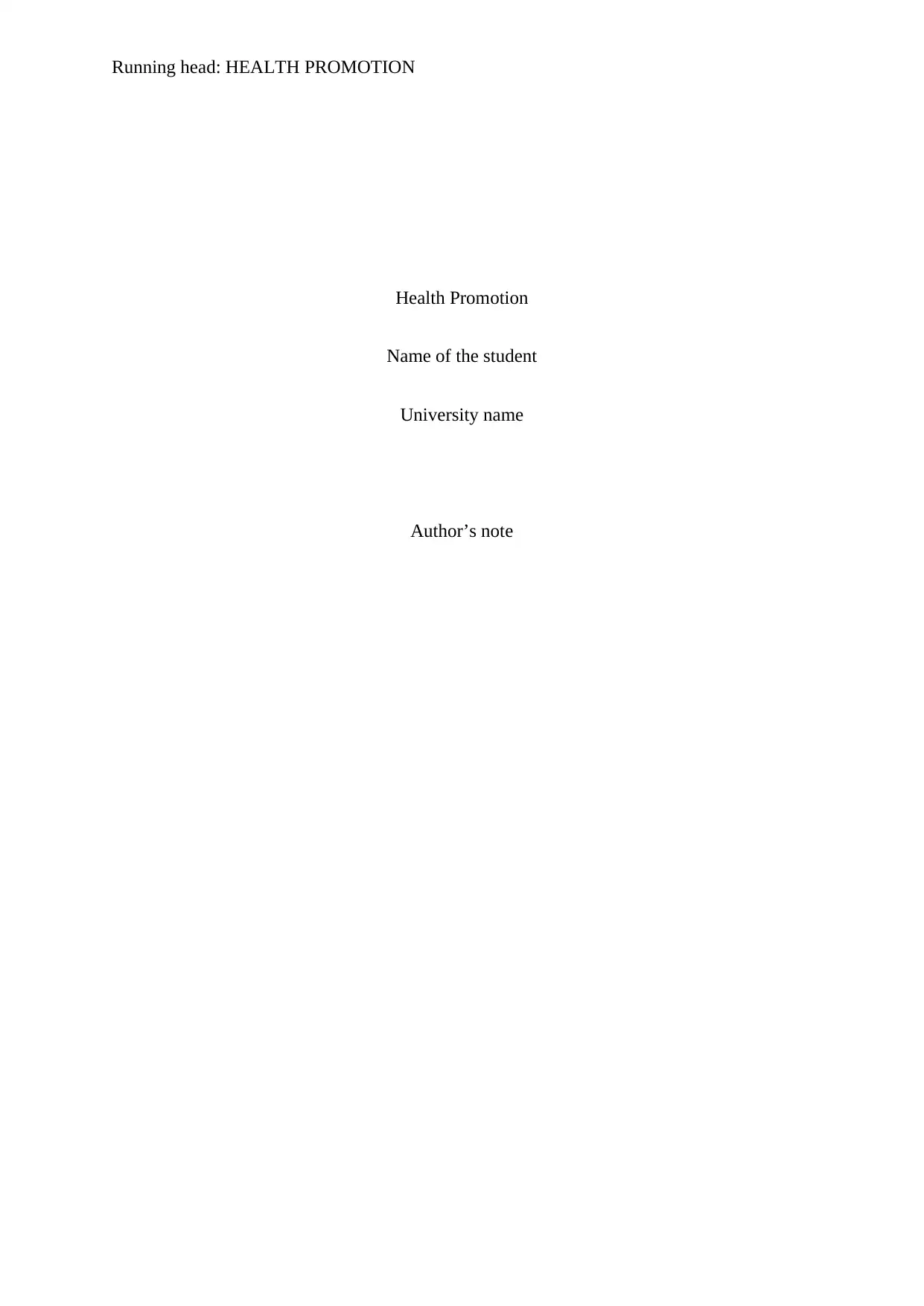
Running head: HEALTH PROMOTION
Health Promotion
Name of the student
University name
Author’s note
Health Promotion
Name of the student
University name
Author’s note
Paraphrase This Document
Need a fresh take? Get an instant paraphrase of this document with our AI Paraphraser
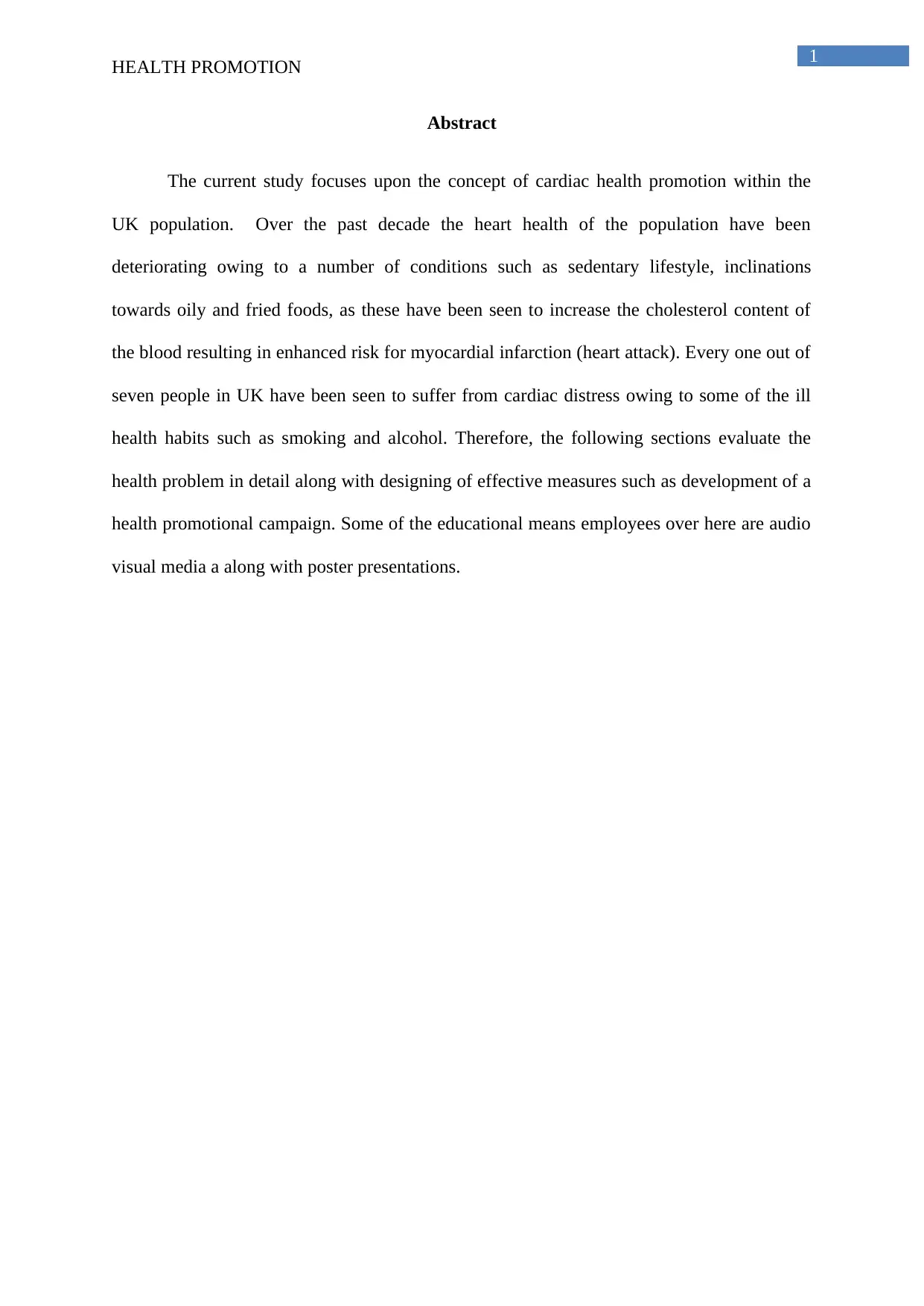
1
HEALTH PROMOTION
Abstract
The current study focuses upon the concept of cardiac health promotion within the
UK population. Over the past decade the heart health of the population have been
deteriorating owing to a number of conditions such as sedentary lifestyle, inclinations
towards oily and fried foods, as these have been seen to increase the cholesterol content of
the blood resulting in enhanced risk for myocardial infarction (heart attack). Every one out of
seven people in UK have been seen to suffer from cardiac distress owing to some of the ill
health habits such as smoking and alcohol. Therefore, the following sections evaluate the
health problem in detail along with designing of effective measures such as development of a
health promotional campaign. Some of the educational means employees over here are audio
visual media a along with poster presentations.
HEALTH PROMOTION
Abstract
The current study focuses upon the concept of cardiac health promotion within the
UK population. Over the past decade the heart health of the population have been
deteriorating owing to a number of conditions such as sedentary lifestyle, inclinations
towards oily and fried foods, as these have been seen to increase the cholesterol content of
the blood resulting in enhanced risk for myocardial infarction (heart attack). Every one out of
seven people in UK have been seen to suffer from cardiac distress owing to some of the ill
health habits such as smoking and alcohol. Therefore, the following sections evaluate the
health problem in detail along with designing of effective measures such as development of a
health promotional campaign. Some of the educational means employees over here are audio
visual media a along with poster presentations.
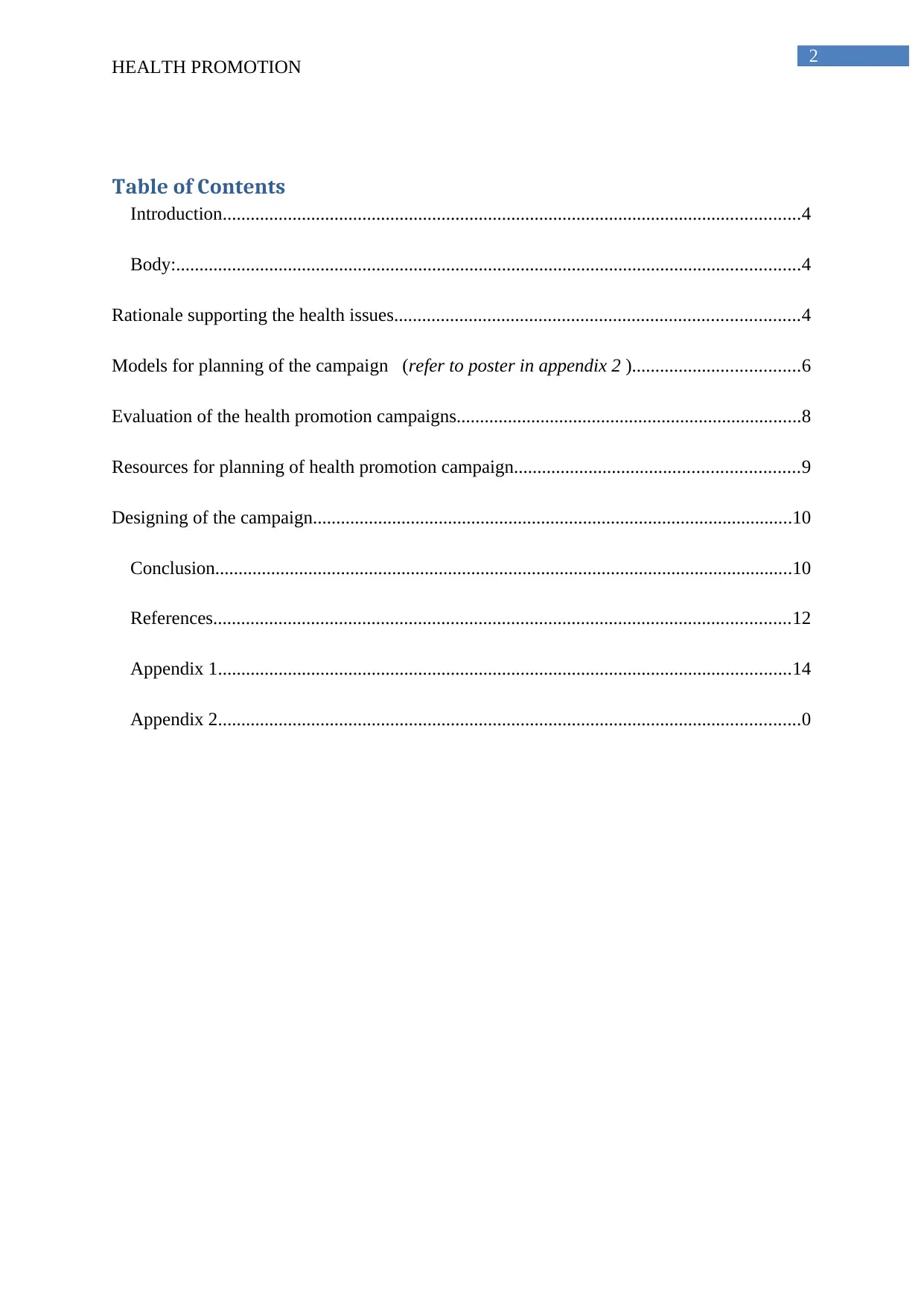
2
HEALTH PROMOTION
Table of Contents
Introduction............................................................................................................................4
Body:......................................................................................................................................4
Rationale supporting the health issues.......................................................................................4
Models for planning of the campaign (refer to poster in appendix 2 )....................................6
Evaluation of the health promotion campaigns..........................................................................8
Resources for planning of health promotion campaign.............................................................9
Designing of the campaign.......................................................................................................10
Conclusion............................................................................................................................10
References............................................................................................................................12
Appendix 1...........................................................................................................................14
Appendix 2.............................................................................................................................0
HEALTH PROMOTION
Table of Contents
Introduction............................................................................................................................4
Body:......................................................................................................................................4
Rationale supporting the health issues.......................................................................................4
Models for planning of the campaign (refer to poster in appendix 2 )....................................6
Evaluation of the health promotion campaigns..........................................................................8
Resources for planning of health promotion campaign.............................................................9
Designing of the campaign.......................................................................................................10
Conclusion............................................................................................................................10
References............................................................................................................................12
Appendix 1...........................................................................................................................14
Appendix 2.............................................................................................................................0
⊘ This is a preview!⊘
Do you want full access?
Subscribe today to unlock all pages.

Trusted by 1+ million students worldwide
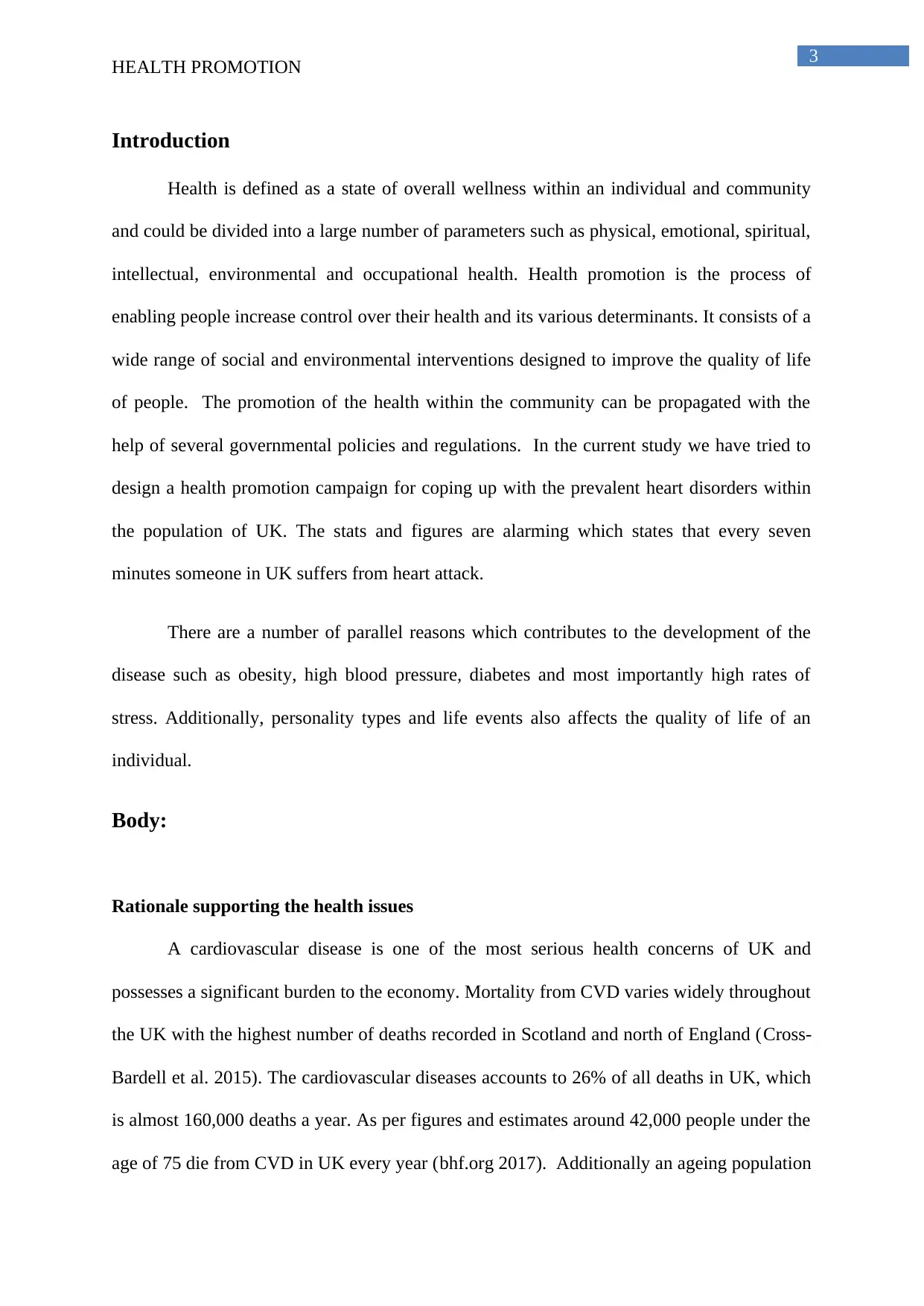
3
HEALTH PROMOTION
Introduction
Health is defined as a state of overall wellness within an individual and community
and could be divided into a large number of parameters such as physical, emotional, spiritual,
intellectual, environmental and occupational health. Health promotion is the process of
enabling people increase control over their health and its various determinants. It consists of a
wide range of social and environmental interventions designed to improve the quality of life
of people. The promotion of the health within the community can be propagated with the
help of several governmental policies and regulations. In the current study we have tried to
design a health promotion campaign for coping up with the prevalent heart disorders within
the population of UK. The stats and figures are alarming which states that every seven
minutes someone in UK suffers from heart attack.
There are a number of parallel reasons which contributes to the development of the
disease such as obesity, high blood pressure, diabetes and most importantly high rates of
stress. Additionally, personality types and life events also affects the quality of life of an
individual.
Body:
Rationale supporting the health issues
A cardiovascular disease is one of the most serious health concerns of UK and
possesses a significant burden to the economy. Mortality from CVD varies widely throughout
the UK with the highest number of deaths recorded in Scotland and north of England (Cross-
Bardell et al. 2015). The cardiovascular diseases accounts to 26% of all deaths in UK, which
is almost 160,000 deaths a year. As per figures and estimates around 42,000 people under the
age of 75 die from CVD in UK every year (bhf.org 2017). Additionally an ageing population
HEALTH PROMOTION
Introduction
Health is defined as a state of overall wellness within an individual and community
and could be divided into a large number of parameters such as physical, emotional, spiritual,
intellectual, environmental and occupational health. Health promotion is the process of
enabling people increase control over their health and its various determinants. It consists of a
wide range of social and environmental interventions designed to improve the quality of life
of people. The promotion of the health within the community can be propagated with the
help of several governmental policies and regulations. In the current study we have tried to
design a health promotion campaign for coping up with the prevalent heart disorders within
the population of UK. The stats and figures are alarming which states that every seven
minutes someone in UK suffers from heart attack.
There are a number of parallel reasons which contributes to the development of the
disease such as obesity, high blood pressure, diabetes and most importantly high rates of
stress. Additionally, personality types and life events also affects the quality of life of an
individual.
Body:
Rationale supporting the health issues
A cardiovascular disease is one of the most serious health concerns of UK and
possesses a significant burden to the economy. Mortality from CVD varies widely throughout
the UK with the highest number of deaths recorded in Scotland and north of England (Cross-
Bardell et al. 2015). The cardiovascular diseases accounts to 26% of all deaths in UK, which
is almost 160,000 deaths a year. As per figures and estimates around 42,000 people under the
age of 75 die from CVD in UK every year (bhf.org 2017). Additionally an ageing population
Paraphrase This Document
Need a fresh take? Get an instant paraphrase of this document with our AI Paraphraser
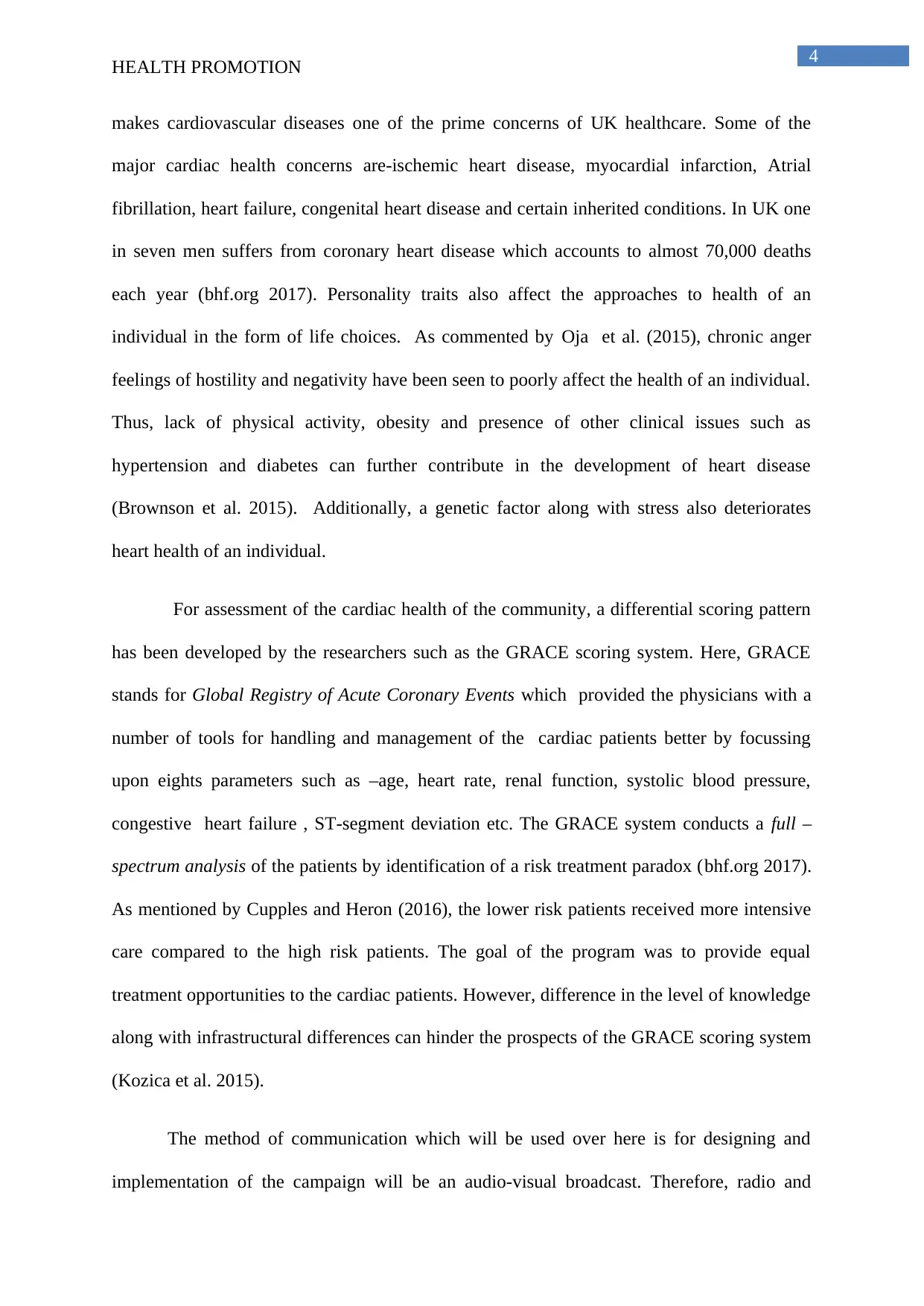
4
HEALTH PROMOTION
makes cardiovascular diseases one of the prime concerns of UK healthcare. Some of the
major cardiac health concerns are-ischemic heart disease, myocardial infarction, Atrial
fibrillation, heart failure, congenital heart disease and certain inherited conditions. In UK one
in seven men suffers from coronary heart disease which accounts to almost 70,000 deaths
each year (bhf.org 2017). Personality traits also affect the approaches to health of an
individual in the form of life choices. As commented by Oja et al. (2015), chronic anger
feelings of hostility and negativity have been seen to poorly affect the health of an individual.
Thus, lack of physical activity, obesity and presence of other clinical issues such as
hypertension and diabetes can further contribute in the development of heart disease
(Brownson et al. 2015). Additionally, a genetic factor along with stress also deteriorates
heart health of an individual.
For assessment of the cardiac health of the community, a differential scoring pattern
has been developed by the researchers such as the GRACE scoring system. Here, GRACE
stands for Global Registry of Acute Coronary Events which provided the physicians with a
number of tools for handling and management of the cardiac patients better by focussing
upon eights parameters such as –age, heart rate, renal function, systolic blood pressure,
congestive heart failure , ST-segment deviation etc. The GRACE system conducts a full –
spectrum analysis of the patients by identification of a risk treatment paradox (bhf.org 2017).
As mentioned by Cupples and Heron (2016), the lower risk patients received more intensive
care compared to the high risk patients. The goal of the program was to provide equal
treatment opportunities to the cardiac patients. However, difference in the level of knowledge
along with infrastructural differences can hinder the prospects of the GRACE scoring system
(Kozica et al. 2015).
The method of communication which will be used over here is for designing and
implementation of the campaign will be an audio-visual broadcast. Therefore, radio and
HEALTH PROMOTION
makes cardiovascular diseases one of the prime concerns of UK healthcare. Some of the
major cardiac health concerns are-ischemic heart disease, myocardial infarction, Atrial
fibrillation, heart failure, congenital heart disease and certain inherited conditions. In UK one
in seven men suffers from coronary heart disease which accounts to almost 70,000 deaths
each year (bhf.org 2017). Personality traits also affect the approaches to health of an
individual in the form of life choices. As commented by Oja et al. (2015), chronic anger
feelings of hostility and negativity have been seen to poorly affect the health of an individual.
Thus, lack of physical activity, obesity and presence of other clinical issues such as
hypertension and diabetes can further contribute in the development of heart disease
(Brownson et al. 2015). Additionally, a genetic factor along with stress also deteriorates
heart health of an individual.
For assessment of the cardiac health of the community, a differential scoring pattern
has been developed by the researchers such as the GRACE scoring system. Here, GRACE
stands for Global Registry of Acute Coronary Events which provided the physicians with a
number of tools for handling and management of the cardiac patients better by focussing
upon eights parameters such as –age, heart rate, renal function, systolic blood pressure,
congestive heart failure , ST-segment deviation etc. The GRACE system conducts a full –
spectrum analysis of the patients by identification of a risk treatment paradox (bhf.org 2017).
As mentioned by Cupples and Heron (2016), the lower risk patients received more intensive
care compared to the high risk patients. The goal of the program was to provide equal
treatment opportunities to the cardiac patients. However, difference in the level of knowledge
along with infrastructural differences can hinder the prospects of the GRACE scoring system
(Kozica et al. 2015).
The method of communication which will be used over here is for designing and
implementation of the campaign will be an audio-visual broadcast. Therefore, radio and
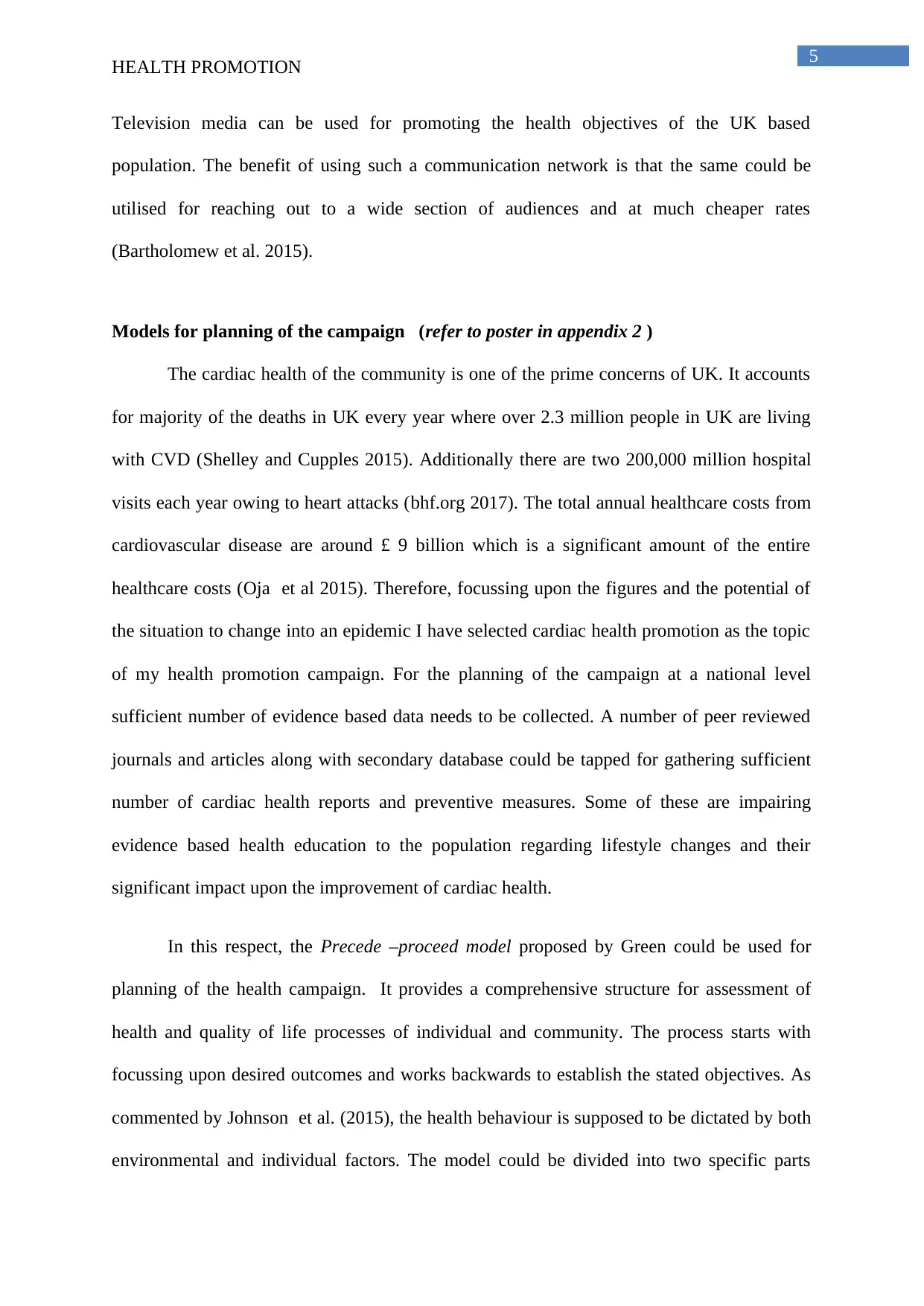
5
HEALTH PROMOTION
Television media can be used for promoting the health objectives of the UK based
population. The benefit of using such a communication network is that the same could be
utilised for reaching out to a wide section of audiences and at much cheaper rates
(Bartholomew et al. 2015).
Models for planning of the campaign (refer to poster in appendix 2 )
The cardiac health of the community is one of the prime concerns of UK. It accounts
for majority of the deaths in UK every year where over 2.3 million people in UK are living
with CVD (Shelley and Cupples 2015). Additionally there are two 200,000 million hospital
visits each year owing to heart attacks (bhf.org 2017). The total annual healthcare costs from
cardiovascular disease are around £ 9 billion which is a significant amount of the entire
healthcare costs (Oja et al 2015). Therefore, focussing upon the figures and the potential of
the situation to change into an epidemic I have selected cardiac health promotion as the topic
of my health promotion campaign. For the planning of the campaign at a national level
sufficient number of evidence based data needs to be collected. A number of peer reviewed
journals and articles along with secondary database could be tapped for gathering sufficient
number of cardiac health reports and preventive measures. Some of these are impairing
evidence based health education to the population regarding lifestyle changes and their
significant impact upon the improvement of cardiac health.
In this respect, the Precede –proceed model proposed by Green could be used for
planning of the health campaign. It provides a comprehensive structure for assessment of
health and quality of life processes of individual and community. The process starts with
focussing upon desired outcomes and works backwards to establish the stated objectives. As
commented by Johnson et al. (2015), the health behaviour is supposed to be dictated by both
environmental and individual factors. The model could be divided into two specific parts
HEALTH PROMOTION
Television media can be used for promoting the health objectives of the UK based
population. The benefit of using such a communication network is that the same could be
utilised for reaching out to a wide section of audiences and at much cheaper rates
(Bartholomew et al. 2015).
Models for planning of the campaign (refer to poster in appendix 2 )
The cardiac health of the community is one of the prime concerns of UK. It accounts
for majority of the deaths in UK every year where over 2.3 million people in UK are living
with CVD (Shelley and Cupples 2015). Additionally there are two 200,000 million hospital
visits each year owing to heart attacks (bhf.org 2017). The total annual healthcare costs from
cardiovascular disease are around £ 9 billion which is a significant amount of the entire
healthcare costs (Oja et al 2015). Therefore, focussing upon the figures and the potential of
the situation to change into an epidemic I have selected cardiac health promotion as the topic
of my health promotion campaign. For the planning of the campaign at a national level
sufficient number of evidence based data needs to be collected. A number of peer reviewed
journals and articles along with secondary database could be tapped for gathering sufficient
number of cardiac health reports and preventive measures. Some of these are impairing
evidence based health education to the population regarding lifestyle changes and their
significant impact upon the improvement of cardiac health.
In this respect, the Precede –proceed model proposed by Green could be used for
planning of the health campaign. It provides a comprehensive structure for assessment of
health and quality of life processes of individual and community. The process starts with
focussing upon desired outcomes and works backwards to establish the stated objectives. As
commented by Johnson et al. (2015), the health behaviour is supposed to be dictated by both
environmental and individual factors. The model could be divided into two specific parts
⊘ This is a preview!⊘
Do you want full access?
Subscribe today to unlock all pages.

Trusted by 1+ million students worldwide
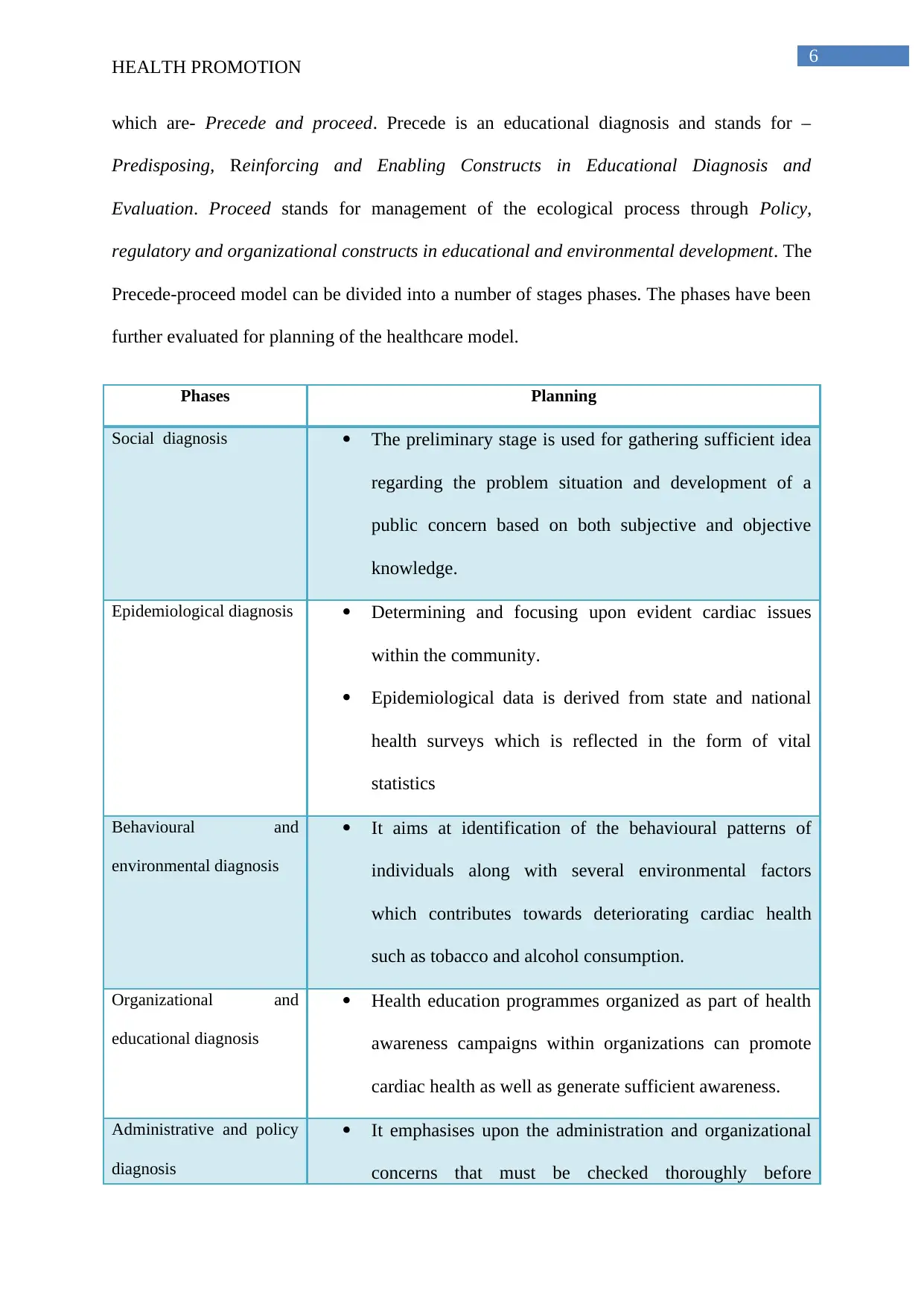
6
HEALTH PROMOTION
which are- Precede and proceed. Precede is an educational diagnosis and stands for –
Predisposing, Reinforcing and Enabling Constructs in Educational Diagnosis and
Evaluation. Proceed stands for management of the ecological process through Policy,
regulatory and organizational constructs in educational and environmental development. The
Precede-proceed model can be divided into a number of stages phases. The phases have been
further evaluated for planning of the healthcare model.
Phases Planning
Social diagnosis The preliminary stage is used for gathering sufficient idea
regarding the problem situation and development of a
public concern based on both subjective and objective
knowledge.
Epidemiological diagnosis Determining and focusing upon evident cardiac issues
within the community.
Epidemiological data is derived from state and national
health surveys which is reflected in the form of vital
statistics
Behavioural and
environmental diagnosis
It aims at identification of the behavioural patterns of
individuals along with several environmental factors
which contributes towards deteriorating cardiac health
such as tobacco and alcohol consumption.
Organizational and
educational diagnosis
Health education programmes organized as part of health
awareness campaigns within organizations can promote
cardiac health as well as generate sufficient awareness.
Administrative and policy
diagnosis
It emphasises upon the administration and organizational
concerns that must be checked thoroughly before
HEALTH PROMOTION
which are- Precede and proceed. Precede is an educational diagnosis and stands for –
Predisposing, Reinforcing and Enabling Constructs in Educational Diagnosis and
Evaluation. Proceed stands for management of the ecological process through Policy,
regulatory and organizational constructs in educational and environmental development. The
Precede-proceed model can be divided into a number of stages phases. The phases have been
further evaluated for planning of the healthcare model.
Phases Planning
Social diagnosis The preliminary stage is used for gathering sufficient idea
regarding the problem situation and development of a
public concern based on both subjective and objective
knowledge.
Epidemiological diagnosis Determining and focusing upon evident cardiac issues
within the community.
Epidemiological data is derived from state and national
health surveys which is reflected in the form of vital
statistics
Behavioural and
environmental diagnosis
It aims at identification of the behavioural patterns of
individuals along with several environmental factors
which contributes towards deteriorating cardiac health
such as tobacco and alcohol consumption.
Organizational and
educational diagnosis
Health education programmes organized as part of health
awareness campaigns within organizations can promote
cardiac health as well as generate sufficient awareness.
Administrative and policy
diagnosis
It emphasises upon the administration and organizational
concerns that must be checked thoroughly before
Paraphrase This Document
Need a fresh take? Get an instant paraphrase of this document with our AI Paraphraser
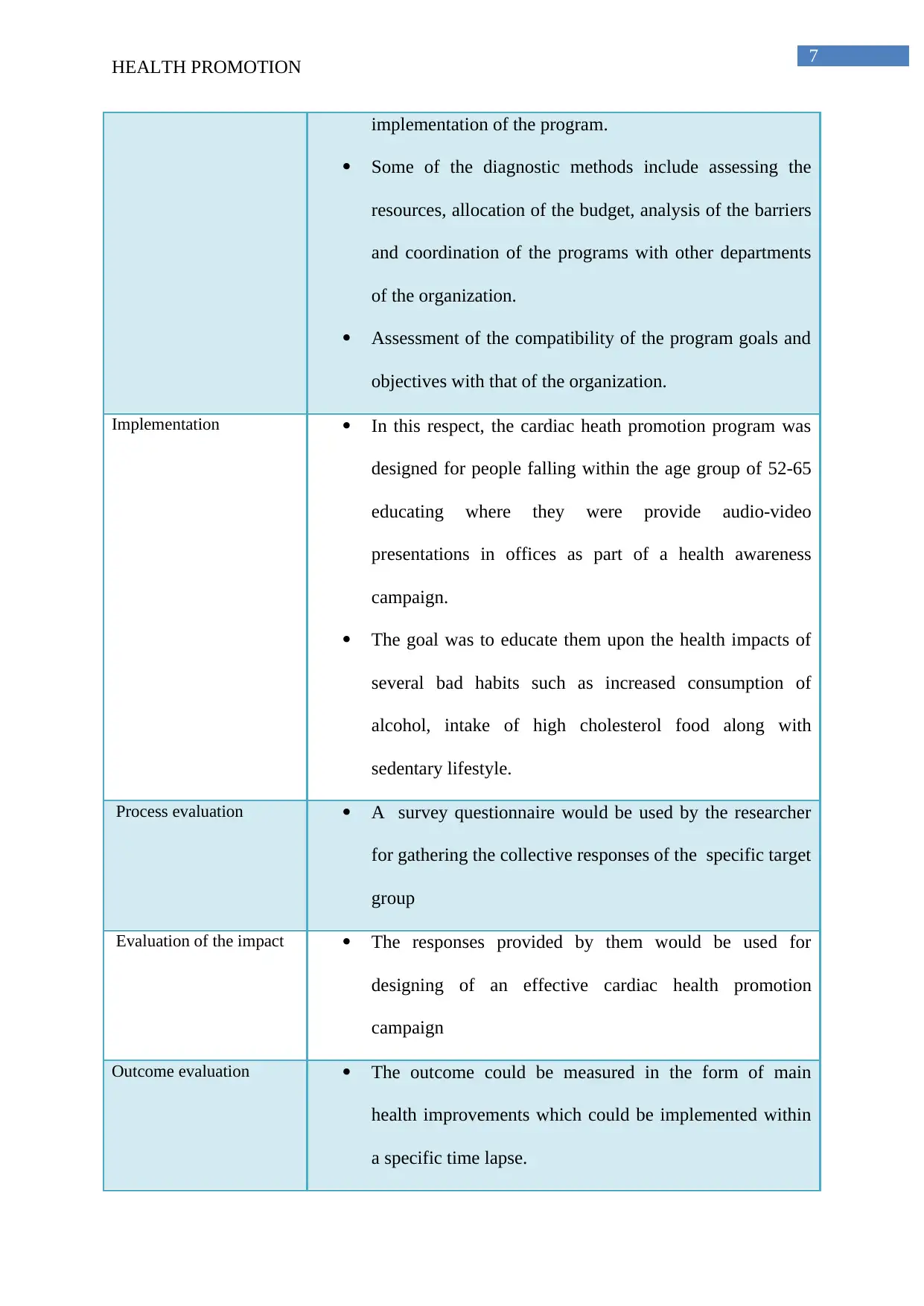
7
HEALTH PROMOTION
implementation of the program.
Some of the diagnostic methods include assessing the
resources, allocation of the budget, analysis of the barriers
and coordination of the programs with other departments
of the organization.
Assessment of the compatibility of the program goals and
objectives with that of the organization.
Implementation In this respect, the cardiac heath promotion program was
designed for people falling within the age group of 52-65
educating where they were provide audio-video
presentations in offices as part of a health awareness
campaign.
The goal was to educate them upon the health impacts of
several bad habits such as increased consumption of
alcohol, intake of high cholesterol food along with
sedentary lifestyle.
Process evaluation A survey questionnaire would be used by the researcher
for gathering the collective responses of the specific target
group
Evaluation of the impact The responses provided by them would be used for
designing of an effective cardiac health promotion
campaign
Outcome evaluation The outcome could be measured in the form of main
health improvements which could be implemented within
a specific time lapse.
HEALTH PROMOTION
implementation of the program.
Some of the diagnostic methods include assessing the
resources, allocation of the budget, analysis of the barriers
and coordination of the programs with other departments
of the organization.
Assessment of the compatibility of the program goals and
objectives with that of the organization.
Implementation In this respect, the cardiac heath promotion program was
designed for people falling within the age group of 52-65
educating where they were provide audio-video
presentations in offices as part of a health awareness
campaign.
The goal was to educate them upon the health impacts of
several bad habits such as increased consumption of
alcohol, intake of high cholesterol food along with
sedentary lifestyle.
Process evaluation A survey questionnaire would be used by the researcher
for gathering the collective responses of the specific target
group
Evaluation of the impact The responses provided by them would be used for
designing of an effective cardiac health promotion
campaign
Outcome evaluation The outcome could be measured in the form of main
health improvements which could be implemented within
a specific time lapse.
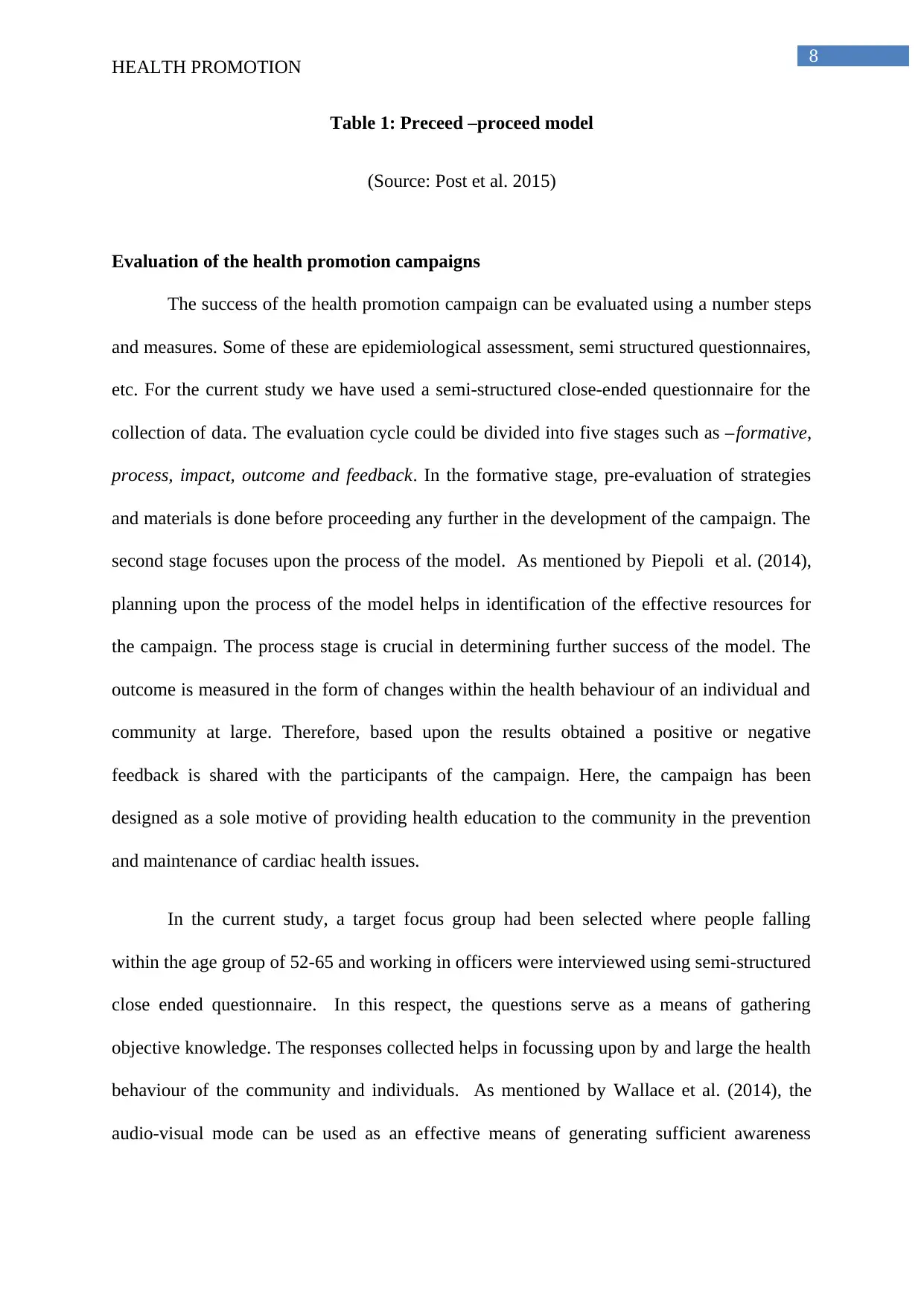
8
HEALTH PROMOTION
Table 1: Preceed –proceed model
(Source: Post et al. 2015)
Evaluation of the health promotion campaigns
The success of the health promotion campaign can be evaluated using a number steps
and measures. Some of these are epidemiological assessment, semi structured questionnaires,
etc. For the current study we have used a semi-structured close-ended questionnaire for the
collection of data. The evaluation cycle could be divided into five stages such as –formative,
process, impact, outcome and feedback. In the formative stage, pre-evaluation of strategies
and materials is done before proceeding any further in the development of the campaign. The
second stage focuses upon the process of the model. As mentioned by Piepoli et al. (2014),
planning upon the process of the model helps in identification of the effective resources for
the campaign. The process stage is crucial in determining further success of the model. The
outcome is measured in the form of changes within the health behaviour of an individual and
community at large. Therefore, based upon the results obtained a positive or negative
feedback is shared with the participants of the campaign. Here, the campaign has been
designed as a sole motive of providing health education to the community in the prevention
and maintenance of cardiac health issues.
In the current study, a target focus group had been selected where people falling
within the age group of 52-65 and working in officers were interviewed using semi-structured
close ended questionnaire. In this respect, the questions serve as a means of gathering
objective knowledge. The responses collected helps in focussing upon by and large the health
behaviour of the community and individuals. As mentioned by Wallace et al. (2014), the
audio-visual mode can be used as an effective means of generating sufficient awareness
HEALTH PROMOTION
Table 1: Preceed –proceed model
(Source: Post et al. 2015)
Evaluation of the health promotion campaigns
The success of the health promotion campaign can be evaluated using a number steps
and measures. Some of these are epidemiological assessment, semi structured questionnaires,
etc. For the current study we have used a semi-structured close-ended questionnaire for the
collection of data. The evaluation cycle could be divided into five stages such as –formative,
process, impact, outcome and feedback. In the formative stage, pre-evaluation of strategies
and materials is done before proceeding any further in the development of the campaign. The
second stage focuses upon the process of the model. As mentioned by Piepoli et al. (2014),
planning upon the process of the model helps in identification of the effective resources for
the campaign. The process stage is crucial in determining further success of the model. The
outcome is measured in the form of changes within the health behaviour of an individual and
community at large. Therefore, based upon the results obtained a positive or negative
feedback is shared with the participants of the campaign. Here, the campaign has been
designed as a sole motive of providing health education to the community in the prevention
and maintenance of cardiac health issues.
In the current study, a target focus group had been selected where people falling
within the age group of 52-65 and working in officers were interviewed using semi-structured
close ended questionnaire. In this respect, the questions serve as a means of gathering
objective knowledge. The responses collected helps in focussing upon by and large the health
behaviour of the community and individuals. As mentioned by Wallace et al. (2014), the
audio-visual mode can be used as an effective means of generating sufficient awareness
⊘ This is a preview!⊘
Do you want full access?
Subscribe today to unlock all pages.

Trusted by 1+ million students worldwide
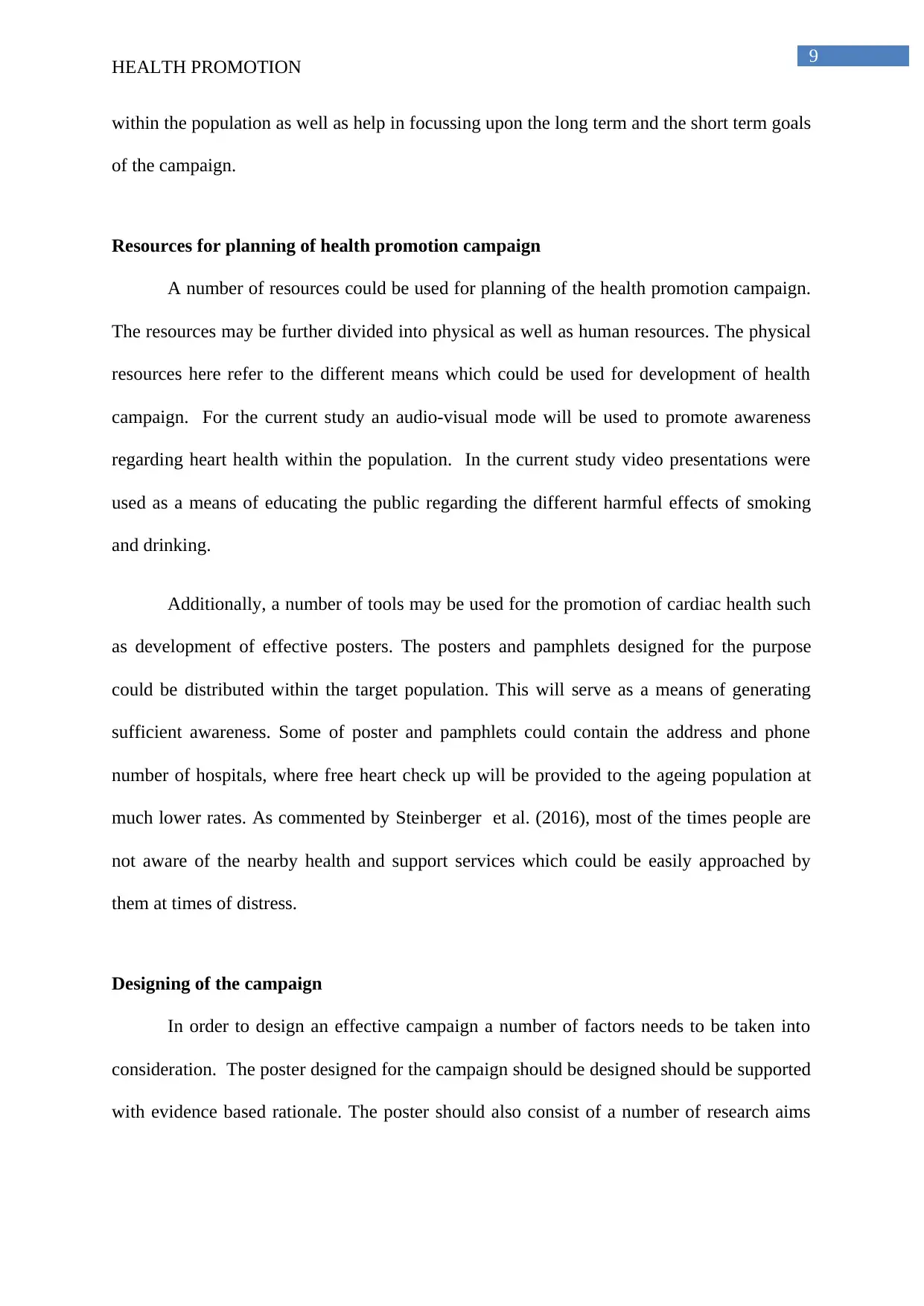
9
HEALTH PROMOTION
within the population as well as help in focussing upon the long term and the short term goals
of the campaign.
Resources for planning of health promotion campaign
A number of resources could be used for planning of the health promotion campaign.
The resources may be further divided into physical as well as human resources. The physical
resources here refer to the different means which could be used for development of health
campaign. For the current study an audio-visual mode will be used to promote awareness
regarding heart health within the population. In the current study video presentations were
used as a means of educating the public regarding the different harmful effects of smoking
and drinking.
Additionally, a number of tools may be used for the promotion of cardiac health such
as development of effective posters. The posters and pamphlets designed for the purpose
could be distributed within the target population. This will serve as a means of generating
sufficient awareness. Some of poster and pamphlets could contain the address and phone
number of hospitals, where free heart check up will be provided to the ageing population at
much lower rates. As commented by Steinberger et al. (2016), most of the times people are
not aware of the nearby health and support services which could be easily approached by
them at times of distress.
Designing of the campaign
In order to design an effective campaign a number of factors needs to be taken into
consideration. The poster designed for the campaign should be designed should be supported
with evidence based rationale. The poster should also consist of a number of research aims
HEALTH PROMOTION
within the population as well as help in focussing upon the long term and the short term goals
of the campaign.
Resources for planning of health promotion campaign
A number of resources could be used for planning of the health promotion campaign.
The resources may be further divided into physical as well as human resources. The physical
resources here refer to the different means which could be used for development of health
campaign. For the current study an audio-visual mode will be used to promote awareness
regarding heart health within the population. In the current study video presentations were
used as a means of educating the public regarding the different harmful effects of smoking
and drinking.
Additionally, a number of tools may be used for the promotion of cardiac health such
as development of effective posters. The posters and pamphlets designed for the purpose
could be distributed within the target population. This will serve as a means of generating
sufficient awareness. Some of poster and pamphlets could contain the address and phone
number of hospitals, where free heart check up will be provided to the ageing population at
much lower rates. As commented by Steinberger et al. (2016), most of the times people are
not aware of the nearby health and support services which could be easily approached by
them at times of distress.
Designing of the campaign
In order to design an effective campaign a number of factors needs to be taken into
consideration. The poster designed for the campaign should be designed should be supported
with evidence based rationale. The poster should also consist of a number of research aims
Paraphrase This Document
Need a fresh take? Get an instant paraphrase of this document with our AI Paraphraser
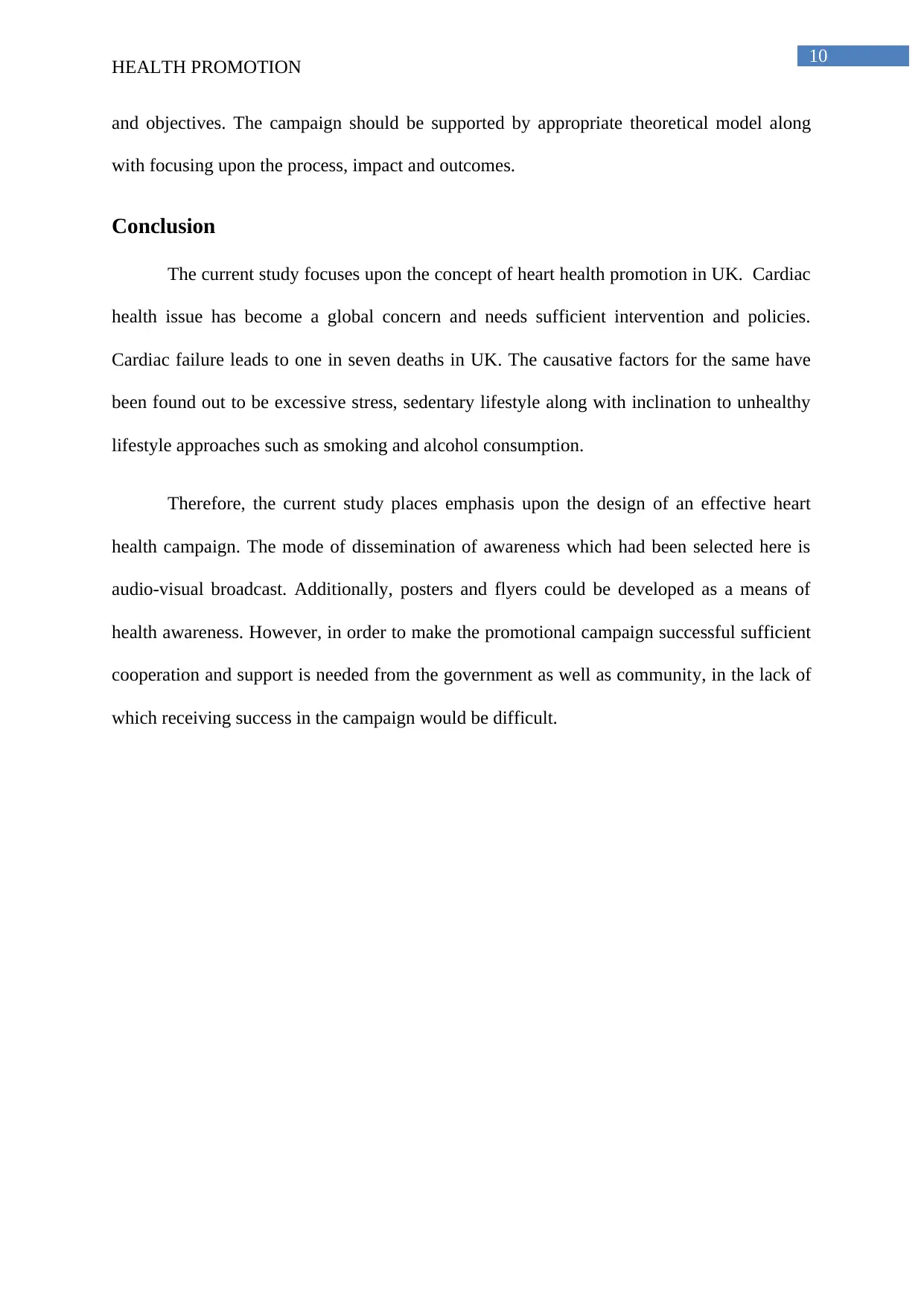
10
HEALTH PROMOTION
and objectives. The campaign should be supported by appropriate theoretical model along
with focusing upon the process, impact and outcomes.
Conclusion
The current study focuses upon the concept of heart health promotion in UK. Cardiac
health issue has become a global concern and needs sufficient intervention and policies.
Cardiac failure leads to one in seven deaths in UK. The causative factors for the same have
been found out to be excessive stress, sedentary lifestyle along with inclination to unhealthy
lifestyle approaches such as smoking and alcohol consumption.
Therefore, the current study places emphasis upon the design of an effective heart
health campaign. The mode of dissemination of awareness which had been selected here is
audio-visual broadcast. Additionally, posters and flyers could be developed as a means of
health awareness. However, in order to make the promotional campaign successful sufficient
cooperation and support is needed from the government as well as community, in the lack of
which receiving success in the campaign would be difficult.
HEALTH PROMOTION
and objectives. The campaign should be supported by appropriate theoretical model along
with focusing upon the process, impact and outcomes.
Conclusion
The current study focuses upon the concept of heart health promotion in UK. Cardiac
health issue has become a global concern and needs sufficient intervention and policies.
Cardiac failure leads to one in seven deaths in UK. The causative factors for the same have
been found out to be excessive stress, sedentary lifestyle along with inclination to unhealthy
lifestyle approaches such as smoking and alcohol consumption.
Therefore, the current study places emphasis upon the design of an effective heart
health campaign. The mode of dissemination of awareness which had been selected here is
audio-visual broadcast. Additionally, posters and flyers could be developed as a means of
health awareness. However, in order to make the promotional campaign successful sufficient
cooperation and support is needed from the government as well as community, in the lack of
which receiving success in the campaign would be difficult.
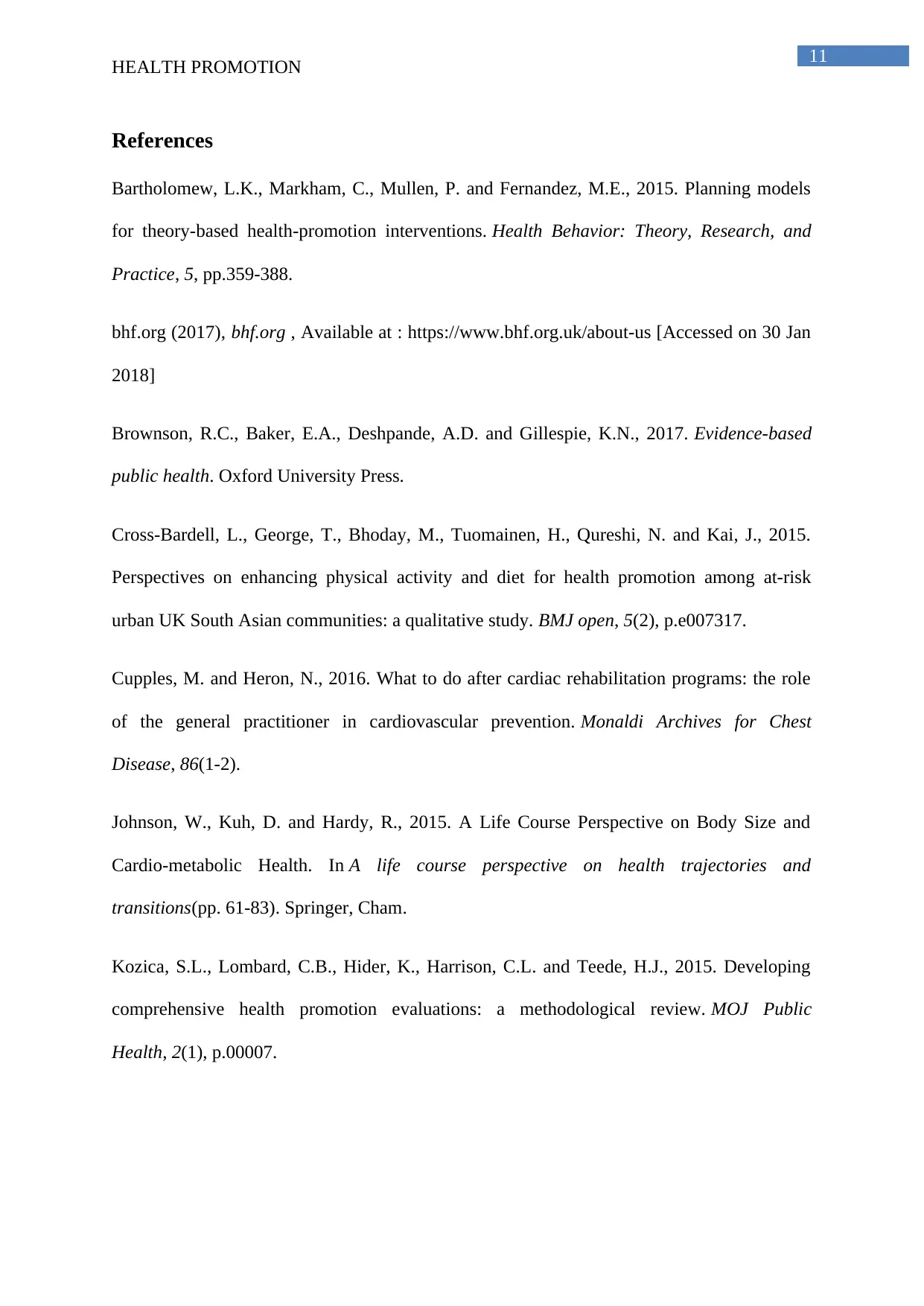
11
HEALTH PROMOTION
References
Bartholomew, L.K., Markham, C., Mullen, P. and Fernandez, M.E., 2015. Planning models
for theory-based health-promotion interventions. Health Behavior: Theory, Research, and
Practice, 5, pp.359-388.
bhf.org (2017), bhf.org , Available at : https://www.bhf.org.uk/about-us [Accessed on 30 Jan
2018]
Brownson, R.C., Baker, E.A., Deshpande, A.D. and Gillespie, K.N., 2017. Evidence-based
public health. Oxford University Press.
Cross-Bardell, L., George, T., Bhoday, M., Tuomainen, H., Qureshi, N. and Kai, J., 2015.
Perspectives on enhancing physical activity and diet for health promotion among at-risk
urban UK South Asian communities: a qualitative study. BMJ open, 5(2), p.e007317.
Cupples, M. and Heron, N., 2016. What to do after cardiac rehabilitation programs: the role
of the general practitioner in cardiovascular prevention. Monaldi Archives for Chest
Disease, 86(1-2).
Johnson, W., Kuh, D. and Hardy, R., 2015. A Life Course Perspective on Body Size and
Cardio-metabolic Health. In A life course perspective on health trajectories and
transitions(pp. 61-83). Springer, Cham.
Kozica, S.L., Lombard, C.B., Hider, K., Harrison, C.L. and Teede, H.J., 2015. Developing
comprehensive health promotion evaluations: a methodological review. MOJ Public
Health, 2(1), p.00007.
HEALTH PROMOTION
References
Bartholomew, L.K., Markham, C., Mullen, P. and Fernandez, M.E., 2015. Planning models
for theory-based health-promotion interventions. Health Behavior: Theory, Research, and
Practice, 5, pp.359-388.
bhf.org (2017), bhf.org , Available at : https://www.bhf.org.uk/about-us [Accessed on 30 Jan
2018]
Brownson, R.C., Baker, E.A., Deshpande, A.D. and Gillespie, K.N., 2017. Evidence-based
public health. Oxford University Press.
Cross-Bardell, L., George, T., Bhoday, M., Tuomainen, H., Qureshi, N. and Kai, J., 2015.
Perspectives on enhancing physical activity and diet for health promotion among at-risk
urban UK South Asian communities: a qualitative study. BMJ open, 5(2), p.e007317.
Cupples, M. and Heron, N., 2016. What to do after cardiac rehabilitation programs: the role
of the general practitioner in cardiovascular prevention. Monaldi Archives for Chest
Disease, 86(1-2).
Johnson, W., Kuh, D. and Hardy, R., 2015. A Life Course Perspective on Body Size and
Cardio-metabolic Health. In A life course perspective on health trajectories and
transitions(pp. 61-83). Springer, Cham.
Kozica, S.L., Lombard, C.B., Hider, K., Harrison, C.L. and Teede, H.J., 2015. Developing
comprehensive health promotion evaluations: a methodological review. MOJ Public
Health, 2(1), p.00007.
⊘ This is a preview!⊘
Do you want full access?
Subscribe today to unlock all pages.

Trusted by 1+ million students worldwide
1 out of 15
Related Documents
Your All-in-One AI-Powered Toolkit for Academic Success.
+13062052269
info@desklib.com
Available 24*7 on WhatsApp / Email
![[object Object]](/_next/static/media/star-bottom.7253800d.svg)
Unlock your academic potential
Copyright © 2020–2025 A2Z Services. All Rights Reserved. Developed and managed by ZUCOL.





